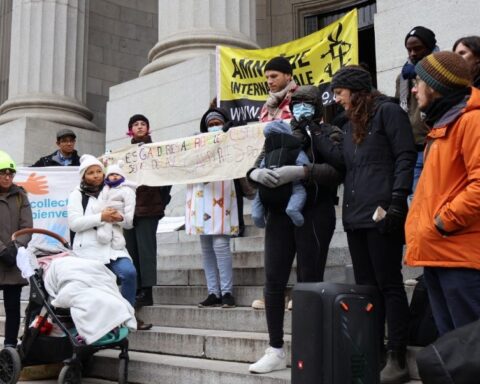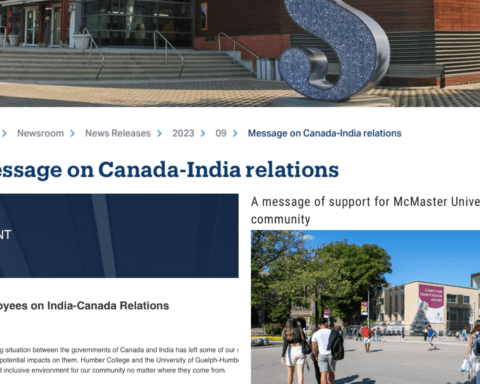“If more people understood the circumstance that brought a migrant worker to the home, and how they are being treated in the home, then they would understand that [the caregiver] is a slave, essentially,” says Hessed Torres, a 34-year-old advocate for migrants and women’s rights.
“[You] work in this condition where you have to forget yourself so that another woman or family can live their lives and thrive.”
Torres would know. She, too, worked as a caregiver not too long ago.
“They weren’t happy that I complained”

Graduating into the recession of 2008, Torres worked odd jobs in the Philippines before deciding to try her luck in Canada.
Online, she found a couple who needed help: the husband had multiple sclerosis and required at-home care. They were willing to sponsor her work permit, which at the time fell under the Live-in Caregiver Program (LCP).
“I didn’t really think about the risks of staying in someone else’s home,” says the nursing graduate from Navotas, a coastal city northwest of the capital. “I just knew I needed to get out of the country and find a job where I can make more money to support my daughter and my family.”
“So I took the risk and came here in 2014.”
The couple that hired her were nice, but working for them, Torres felt like she was constantly being watched. “His wife was pretty strict—she liked to do things a particular way. And that made me really uncomfortable,” she says. “I felt like I was always under surveillance.”
The caregivers who came before her lasted no more than three months, Torres learned. She made it to five.
“There was a time when his wife went to Hawaii, and she had gone for two weeks. I didn’t get a break—I didn’t have a day off straight for two weeks,” she says.
“So I talked to them about the working conditions, that it wasn’t fair. I’m a worker—I’m not a family member that can do all these favours.”
They disagreed. “In my termination letter they said they were firing me because I couldn’t get my driver’s license,” she says.
“But I know obviously what they were terminating me for. They weren’t happy that I complained.”
The end of the LCP
Not long after Torres’ arrival, the LCP ended and the Stephen Harper government introduced the Caring for Children and Caring for People with High Medical Needs pilots.
While the live-in component was removed, the changes made it difficult for Torres to land new work.
Under the new programs, employers had to get a Labour Market Impact Assessment (LMIA) before they could hire her; the LMIA confirms a labour need and the lack of Canadians to fill that need.
It was a year before Torres received a new work permit to look after a family’s one-year-old daughter.
But even as the LCP ended, the exploitative conditions it cultivated lived on.
“It was bearable”
While Torres’ new contract specified she’d be looking after one infant, that wasn’t the case. “They had a friend bring over their daughter, so I took care of two.”
Still, it was better than her previous setup, she says. “And if I complain again, what if I lose this job again?” She took care of the babies until they turned three.
Although she didn’t live with the family, the hours were also long, averaging 11 hours a workday.
“The only thing that softened the situation is that they’re actually nice,” she says. “They’re not home 24-7. And if they are home, they didn’t need me.”
“So it didn’t feel like someone was constantly watching me. It was bearable.”
Policy-enabled exploitation
In 2017, migrant groups across Canada released a report calling for changes to immigration and labour policies that enabled their exploitation.
Among them were calls to end employer-restricted work permits; to remove Canadian-equivalent education requirements for permanent residency, especially when migrant workers are not permitted or able to study while working; and to remove the yearly cap of 2,750 PR applications. With then over 5,500 care workers coming to Canada annually through the child care stream, the cap meant half of them couldn’t get PR even after completing requirements.
The PR backlog has become the bane for many foreign workers who contribute to Canada’s economy. There are caregivers who arrived through the LCP (which ran from 1992 to 2014) and the Harper era programs (2014 to 2019) that are still waiting for decisions on their applications. The 2019 Interim Pathway for Caregivers Program, implemented to address the LCP’s backlog, has yet to clear that backlog.
Three years later, a global pandemic would only exacerbate these problems, as documented in a 2020 report by the Migrant Rights Network.
The Trudeau government has made efforts to address some of these issues with the five-year Home Child Care Provider and Home Support Worker pilots, introduced in 2019. These programs no longer require an LMIA, and foreign caregivers are pre-screened for PR together with their families.
But the new programs have even longer screening times—on top of existing delays.

Tatiane Moraes, a business graduate from Brazil, arrived in 2018 through the Harper-era pilot to work as a caregiver. By the time she completed her two-year work experience requirement and applied for PR in April 2020, the new Trudeau programs were in place. She hasn’t heard back from immigration; in the meantime, she’s had to renew her work permit to continue working.
“I feel like I’m living in limbo,” says the 32-year-old, adding that she’s lucky to be working for a good family.
A streamlined approach
Immigration lawyer Lou Janssen Dangzalan of LJD Law Corporation thinks the caregiver pathways need to be streamlined.
“I don’t blame any particular government for it, but I think there needs to be a cleaning of the shop,” he says. “Establish stable and predictable parameters that people can work with because currently, the program is just untenable.”
This might be possible with Ottawa’s plan to welcome 1.2 million permanent residents in the next three years, he adds.
“I don’t know if the government will meet their targets due to COVID, [but] this is an opportunity to clean up that mess,” he says. “They could create a separate stream under Express Entry because a lot of these caregivers have foreign credentials as nurses and whatnot.”
“It’s just that their work as caregivers in Canada is not recognized as ‘skilled’—which to me is insulting, especially in a time when we realize how important these sets of skills are.”
Calling for change
After her contract was terminated by her first employer, Torres found support in Migrante BC, a community-based organization of Filipino migrant workers.
During this time, Torres says she understood that her experiences were not an isolated case.
“I started to piece together the social issues and the impact our current systems are making us live under—that we’re all just part of the machinery that keeps the system going,” she says.
“Women really bear the brunt,” she adds. “And so I want to do something where I can be of help to women.”
When she received her PR in 2018, Torres resigned from her caregiver job. She wanted to get into a nursing bridging program, but instead landed a role as a women’s support worker with a non-profit. She has worked in the non-profit sector since, and is currently trying to get her daughter to Canada.
She says she wishes more people would know about the caregiver-employer relationship.
“If people just understood that, then maybe they could make the changes happen, because we’ve been asking for changes,” she says. “Make it possible for the caregiver to have status so she has protection.”
Johna Baylon is a freelance journalist and writer based in Vancouver, B.C. She is also NCM's Local Journalism Initiative Reporter. She is drawn to stories around immigration, care work, and communities in the diaspora. Born in the Philippines, Baylon grew up in Hong Kong, where she covered food and design as a writer and editor prior to moving to Canada in 2019. Find her on Twitter @johnabaylon.




